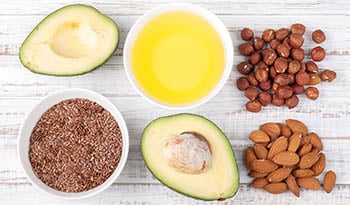The Keto Diet Benefits: Brain Health, Weight Management, and More
DISCLAIMER:This blog does not intend to provide diagnosis...
- In this article:
- What Is the Keto Diet? How Does it Work?
- Keto and Brain Benefits
- Keto and Weight Loss
- Is the Keto Diet Suitable for Long-Term Use?
- Keto Diet Tips
- Important Nutrients for Keto

Originally posted March 2018 / Updated February 2023
What Is the Keto Diet? How Does it Work?
The ketogenic (keto) diet is becoming popular because many people are having success with it for weight loss. The keto diet is also a medically-prescribed diet for certain types of epilepsy.
The keto diet focuses on eating high fats, limited levels of protein, and keeping carbohydrate intake low, e.g., below 50 grams per day. Generally, total calories are divided into 70% fat, 20% protein, and 10% carbohydrates.1
When people consume fewer carbohydrates, the body produces ketones. Ketones are small fuel molecules produced in the liver. With the keto diet, the body switches its fuel supply to regulate primarily fat.
Generally, the body and brain need about 100 grams of carbohydrates to be consumed daily to meet energy needs. So, when carbohydrate intake is low, the skeletal muscle will break down glycogen, the storage form of glucose, and release it into the blood. But this storage is limited. Typically, a person has about two days of stored glucose as glycogen. The body will always require some glucose in the blood to sustain life. The body will start sacrificing muscle and organs containing protein if carbohydrates are not consumed. Some of the amino acids in protein can be converted into glucose by the liver.
Keto and Brain Benefits
When glucose stores are limited, the human brain can utilize a backup energy source. The brain is the most metabolically active tissue in the body. So, it needs a constant energy source. In typical situations, it relies almost exclusively on glucose. When glucose is scarce, the brain can burn compounds known as ketones. These compounds are produced in the liver from fatty acids. Ketones have a strong, characteristic odor and are why many people following a low-carb diet experience bad breath.
With the keto diet, the goal is to enhance the burning of fat for energy as well as produce ketones for brain energy. The keto diet has been shown to be very effective in some instances of epilepsy where drug therapy alone has not controlled seizures. This may result from the keto diet producing lower oxidative stress and improved mitochondrial function. Oxidative stress leads to the aging process and cellular damage, while mitochondria are the energy-producing compartments in cells. Generally, reducing oxidative stress and improving energy production means improved cellular function, especially in the brain, since it is so metabolically active. The keto diet also appears to exert an anti-inflammatory effect on the brain.
As mentioned above, the keto diet is used to treat some cases of epilepsy. It is also being investigated for use in other brain disorders, including Alzheimer’s disease and Parkinson’s disease.2
Keto and Weight Loss
The keto diet can effectively improve glucose control, insulin, and blood lipid levels.1 It can also be used in promoting weight loss. The weight loss effects of a keto diet can be noticeable very early. Most people following a keto see a rapid weight loss of 10 to 12 pounds (4 to 5 kg) within the first two weeks. However, a significant proportion of the initial weight loss is water and muscle mass. Each glycogen molecule binds six molecules of water, so since the keto diet leads to glycogen depletion, it also leads to loss of body water content. That can mean significant weight loss. However, if glycogen levels are restored, some weight loss quickly rebounds. Another caution is that losing muscle mass is a problem for several reasons. As it relates to metabolism, loss of muscle mass can significantly lower the metabolic rate. Lean muscle mass is the primary fat-burning furnace in the body. Losing muscle mass can set metabolism up for weight gain due to less burned fat (calories).
Is the Keto Diet Suitable for Long-Term Use?
While short-term benefits can be achieved with the keto diet, long-term adherence to the keto diet is controversial. First, it is a restrictive diet that not everyone can follow. Second, the keto diet can promote ketosis and high levels of ketones in the blood. This situation is usually not dangerous, though it can be life-threatening if severe. The group at highest risk for severe are diabetics with poor glucose control. The biggest question that needs to be answered sufficiently to date is if the promotion of ketosis is a healthy state. What is known from data from population-based studies is that low carbohydrate diets, in general, may not be suitable for long-term health.3
While refined carbohydrates and highly processed foods containing sugar, white flour, and other refined grain products are problematic carbohydrates, there are a lot of low glycemic fruits, vegetables, and other plant foods that are nutrient-rich and high in dietary fiber that are excluded from the keto diet. Severe exclusion of these foods may be unhealthy. That is where the controversy of keto diets primarily lies.
Compounding the problem of reduced intake of healthy plant foods, many people following the keto diet may focus their calories almost exclusively on animal fats and protein. That also appears to be a problem. In an analysis of over 432,179 subjects, both low carbohydrate consumption (less than <40% of calories) and high carbohydrate consumption (greater than >70% of calories) were associated with greater mortality risk than moderate carbohydrates. Further increasing mortality risk was reducing the carbohydrate intake in exchange for animal-derived fat or protein. However, mortality risk decreased when the reduced carbohydrate substitution was plant-based. Specifically, the keto diet, like dietary patterns focused on animal-derived protein and fat sources such as beef, pork, lamb, and chicken, was linked to higher mortality. In contrast, keto diet-like patterns that focused more on plant-derived protein and fat intake from sources of vegetables, nuts, legumes, and whole grains were linked to lower mortality.3
Keto Diet Tips
While following the keto diet, it is essential to keep carbohydrate intake to less than 50 grams daily. So, it is important to choose carbohydrates wisely. Focus on nutrient-dense, low glycemic choices such as green leafy vegetables such as arugula, spinach, kale, mustard greens, and cabbage family vegetables like broccoli, cauliflower, brussels sprouts, and bok choy, bell peppers, cucumbers, and celery. Berries are also a good choice, but remember that a cup of berries will provide about 25 grams of carbohydrate, or about half the allotment of at most 50 grams daily.
To follow a healthy version of the keto diet it is important to focus on foods rich in health-promoting fats and oils, such as those found in nuts and seeds, olive oil, avocados, fish, and other seafood. It is also important to choose grass-fed varieties of beef, lamb, and other meats.
Important Nutrients for Keto
The keto diet can lead to nutritional deficiencies, especially for thiamine (vitamin B1), folate, vitamin C and D, calcium, magnesium, and potassium. The potassium loss can be significant, so using a potassium chloride-based salt substitute can be very beneficial in keeping potassium levels in the proper range.
The keto diet can also cause disturbed digestive function that leads to gas, bloating, and changes in bowel movements. These minor digestive complaints can sometimes respond favorably to the use of digestive enzymes.
References:
- Nuwaylati D, Eldakhakhny B, Bima A, Sakr H, Elsamanoudy A. Low-Carbohydrate High-Fat Diet: A SWOC Analysis. Metabolites. 2022 Nov 17;12(11):1126.
- Dyńka D, Kowalcze K, Paziewska A. The Role of Ketogenic Diet in the Treatment of Neurological Diseases. Nutrients. 2022 Nov 24;14(23):5003.
- Seidelmann SB, Claggett B, Cheng S, Henglin M, Shah A, Steffen LM, Folsom AR, Rimm EB, Willett WC, Solomon SD. Dietary carbohydrate intake and mortality: a prospective cohort study and meta-analysis. Lancet Public Health. 2018 Sep;3(9):e419-e428.

 By Dr. Michael Murray, N.D.
By Dr. Michael Murray, N.D. 


